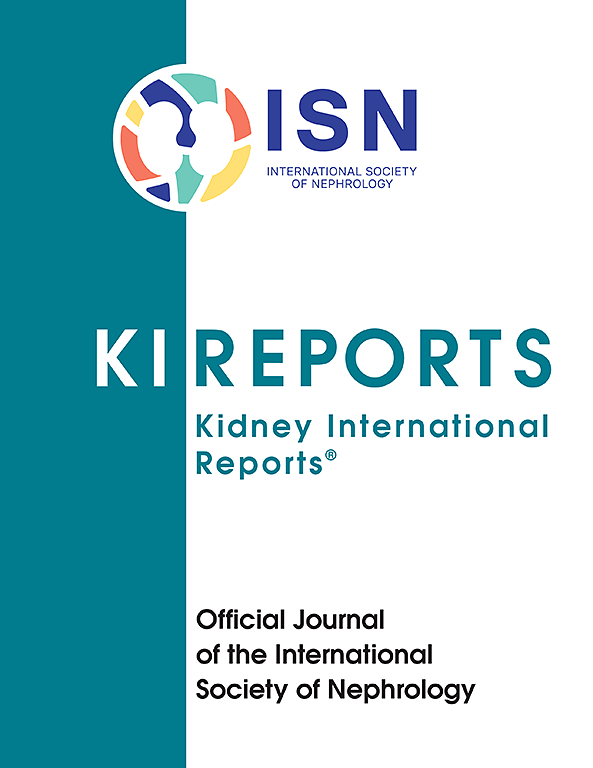Furosemide and Serum Protein-Bound Uremic Toxin Concentrations in Patients With CKD
IF 5.7
2区 医学
Q1 UROLOGY & NEPHROLOGY
引用次数: 0
Abstract
Introduction
Furosemide is commonly prescribed to patients with chronic kidney disease (CKD) but may impair the kidney’s excretion of protein-bound uremic toxins (PBUTs) via the organic anion transporters 1 and 3 (OAT1 and OAT3). We evaluated the association between furosemide prescription (status and dose level) and the serum concentrations of free OAT1/3-inhibiting uremic toxins (UTs) in patients with CKD.
Methods
We included 2342 patients with CKD (stages 2–5) from the CKD–Renal Epidemiology and Information Network (CKD-REIN) cohort and with centralized serum UT assay data at baseline. The UTs were assayed using liquid chromatography - tandem mass spectrometry. The OAT1/3-inhibiting UTs identified in a literature review included indoxyl sulphate (IS), kynurenine (Kyn), p-cresyl sulphate (PCS), and indole-3-acetic acid (IAA). Multiple linear regression was used to assess each PBUT or their sum ( free) as the dependent variable.
Results
Patients prescribed furosemide (n = 799, 34%) were older and had a lower estimated glomerular filtration rate (eGFR), a higher C-reactive protein (CRP) concentration, more comorbidities, and more concomitant medications than patients not prescribed furosemide. After adjustment for potential confounders, patients prescribed > 120 mg furosemide had significantly higher serum concentrations of free (+19.1%), IS (+31.9%), Kyn (+9.3%), PCS (+29.3%), and IAA (+162.9%) than patients not prescribed furosemide. Using a smooth function to model the association between the furosemide dose level and PBUTs, we observed (for free and each free UT) a steep increase between 80 and 100 mg and then a high plateau.
Conclusion
In patients with CKD, furosemide (particularly at a dose level > 120 mg) is independently associated with higher serum free PBUT concentrations. Our findings suggest that drug-UT competition contributes to PBUT accumulation.

慢性肾病患者的速尿和血清蛋白结合尿毒症毒素浓度
速尿通常用于慢性肾病(CKD)患者,但可能损害肾脏通过有机阴离子转运蛋白1和3 (OAT1和OAT3)排泄蛋白结合尿毒症毒素(PBUTs)。我们评估了速尿处方(状态和剂量水平)与CKD患者血清游离oat1 /3抑制尿毒症毒素(UTs)浓度之间的关系。方法我们从CKD-肾脏流行病学和信息网络(CKD- rein)队列中纳入了2342例CKD(2-5期)患者,并在基线时收集了集中的血清UT测定数据。采用液相色谱-串联质谱法测定其含量。文献综述中鉴定的oat1 /3抑制ut包括吲哚酚硫酸盐(IS)、犬尿氨酸(Kyn)、对甲酰硫酸盐(PCS)和吲哚-3-乙酸(IAA)。采用多元线性回归评估各PBUT或其总和(ΣUTs free)作为因变量。结果与未使用呋塞米的患者相比,使用呋塞米的患者年龄较大,肾小球滤过率(eGFR)估计较低,c反应蛋白(CRP)浓度较高,合共病较多,合用药物较多。在对潜在混杂因素进行调整后,患者开了>;120mg呋塞米患者血清中游离ΣUTs(+19.1%)、IS(+31.9%)、Kyn(+9.3%)、PCS(+29.3%)和IAA(+162.9%)浓度显著高于未使用呋塞米的患者。使用平滑函数来模拟速尿剂量水平和PBUTs之间的关系,我们观察到(对于ΣUTs游离UT和每个游离UT)在80到100 mg之间急剧增加,然后是一个高平台。结论在CKD患者中,速尿(特别是在剂量水平>;120 mg)与较高的血清游离PBUT浓度独立相关。我们的研究结果表明,药物- ut竞争有助于PBUT积累。
本文章由计算机程序翻译,如有差异,请以英文原文为准。
求助全文
约1分钟内获得全文
求助全文
来源期刊

Kidney International Reports
Medicine-Nephrology
CiteScore
7.70
自引率
3.30%
发文量
1578
审稿时长
8 weeks
期刊介绍:
Kidney International Reports, an official journal of the International Society of Nephrology, is a peer-reviewed, open access journal devoted to the publication of leading research and developments related to kidney disease. With the primary aim of contributing to improved care of patients with kidney disease, the journal will publish original clinical and select translational articles and educational content related to the pathogenesis, evaluation and management of acute and chronic kidney disease, end stage renal disease (including transplantation), acid-base, fluid and electrolyte disturbances and hypertension. Of particular interest are submissions related to clinical trials, epidemiology, systematic reviews (including meta-analyses) and outcomes research. The journal will also provide a platform for wider dissemination of national and regional guidelines as well as consensus meeting reports.
 求助内容:
求助内容: 应助结果提醒方式:
应助结果提醒方式:


